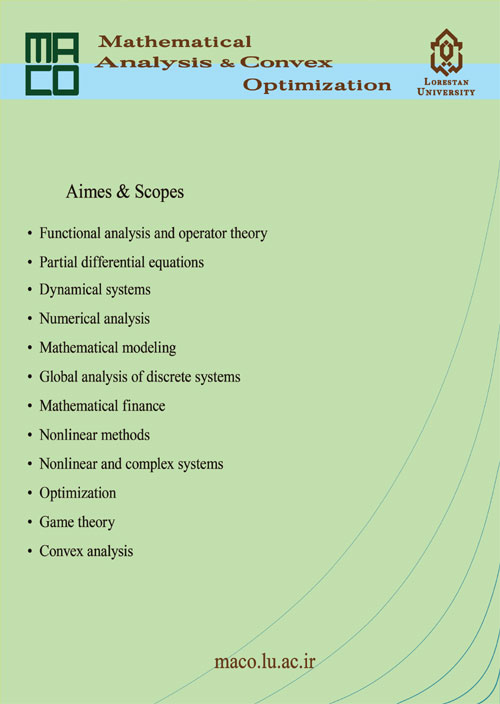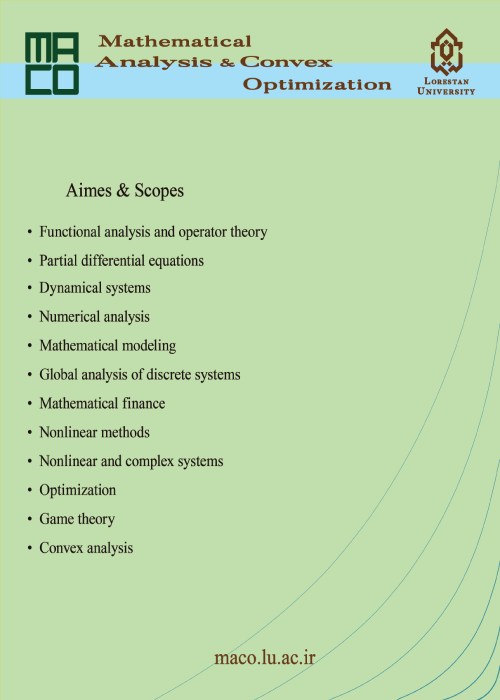فهرست مطالب

Journal of Mathematical Analysis and Convex Optimization
Volume:1 Issue: 2, 2020
- تاریخ انتشار: 1399/10/20
- تعداد عناوین: 12
-
Pages 1-13
In this work, the common T approximate strict fixed point property for multi-valued mappings F,G : X -> P_{cl,bd}(X) is introduced to prove necessary and sucient condition for existence of a common strict xed point of multi-valued mappings involved therein. Our results extend and unify comparable results in the existing literature. We also provide examples to support our results.
Keywords: Multi-valued mapping, common approximate T strict fixed point property, Common strict fixed point, Hausdorff metric -
Pages 15-24
Abstract. Let A, B, and C be Banach algebras, α ∈ Hom(A, B) and β ∈ Hom(C, B), and k α k≤ 1, kβ k≤ 1. IN this paper we define the Banach algebra A×α B×β C by new product on A×B×C which is a strongly splitting extension of C by B. Then we show that these products from a large class of Banach algebras which contains all module extensions and triangular Banach algebras. Finally we consider spectrum, Arens regularity, amenability and weak amenability of these products.
* The formulas are not displayed correctly.
Keywords: strongly splitting extension, triangular Banach algebras, amenability, weak amenability -
Pages 25-34
In this paper, we study conformally flat 4-th root (α, β)-metrics on a manifold $M$ of dimension $ngeq3$. We prove that every conformally flat 4-th root (α, β)-metric with relatively isotropic mean Landsberg curvature must be either Riemannian metrics or locally Minkowski metrics.
* The formulas are not displayed correctly.Keywords: Exponential metric, conformally flat metric, relatively isotropic mean Landsberg curvature -
Pages 35-42
In this paper, we develop a numerical method to solve a famous free boundary PDE called the one dimensional Stefan problem. First, we rewrite the PDE as a variational inequality problem (VIP). Using the linear finite element method, we discretize the variational inequality and achieve a linear complementarity problem (LCP). We present some existence and uniqueness theorems for solutions of the variational inequalities and free boundary problems. Finally we solve the LCP numerically by applying a modification of the active set strategy.
Keywords: Stefan problem, Variational inequalities, Linear complementarity problems -
Pages 43-56
The important issue of the aggregation preference is how to determine the weights associated with different ranking places and DEA models play an important role in this subject. DEA models use assignments of the same aggregate value (equal to unity) to evaluate multiple alternatives as efficient. Furthermore, overly diverse weights can appear, thus, the efficiency of different alternatives obtained by different sets of weights may be unable to be compared and ranked on the same basis. In order to solve two above problems, and rank all the alternatives on the same scale, in this paper, we propose a multiple objective programming (MOP) approach for generating a common set of weights in the DEA framework. Also, we develop a novel model to make a maximum discriminating among candidates’ rankings. Additionally, we present two scenarios to provide suitable strategies for solving the proposed MOP model.
Keywords: Multi-objective programming, Voting, Aggregation of preferences, Data envelopment analysis, Common set of weights, Ranking -
Pages 57-68
In this article, the properties of single-term Walsh series are presented and utilized for solving the nonlinear Volterra-Hammerstein integral equations of second kind. The interval [0;1) is divided tomequal subintervals,mis a positive integer number. The midpoint of each subinterval is chosen as a suitable collocation point. By the method the computations of integral equations reduce into some nonlinear algebraic equations. The method is computationally attractive, and gives a continuous approximate solution. An analysis for the convergence of method is presented.The efficiency and accuracy of the method are demonstrated through illustrative examples. Some comparisons aremade with the existing results.
Keywords: Collocation method, Integral equations, STWS method, Volterra-Hammerstein -
Pages 69-78
We introduce variational inequality problems on 2-inner product spaces and prove several existence results for variational inequalities defined on closed convex sets. Also, the relation between variational inequality problems, best approximation problems and fixed point theory is studied.
Keywords: Variational inequality, 2-Inner product spaces, Fixed point theory, Best approximation -
Pages 79-91
Our aim in this paper, is applying Adams-Moulton algorithm to find the geodesics as the answers of the classical system of ordinary differential equations on a 2-dimensional surface for which a Riemannian metric is defined.
Keywords: Adams-Moulton algorithm, Euclidean space, geodesic, navigation problem, Riemannian manifold, Runge-Kutta algorithm -
Pages 93-99
In this paper we introduce `omega`-proximal quasi contraction mapping and best `omega`-proximity point in modular metric spaces. In fact, we show that
every `omega`-proximal quasi contraction mapping has unique best `omega`-proximity point in modular metric spaces. Finally, we give an example to illustrate the applications of our results.Keywords: modular metric space, best proximity point, proximal quasi contraction map, $omega$-proximal quasi contraction, proximal Picard sequence, T-orbitally $omega$-complete -
Pages 101-106
The main goal of this paper is to propose interval network data envelopment analysis (INDEA) model for performance evaluation of network decision making units (DMUs) with two-stage network structure under data uncertainty. It should be explained that for dealing with uncertainty of data, an interval programming method as a popular uncertainty programming approach is applied. Also, to show the applicability of proposed model, INDEA approach is implemented for performance measurement and ranking of 10 insurance companies from Iranian insurance industry. Note that insurance companies are undoubtedly one of the most important pillars of the financial markets, whose great performance will drive the economy of the country. The empirical results indicate that the proposed INDEA is capable to be utilized to assess the performance of two-stage DMUs in the presence of interval data.
Keywords: Network Data Envelopment Analysis, Two-Stage Structure, Interval Data, Uncertainty, Interval Programming -
Pages 107-120
In this article, two new fixed point results in the framework of complex-valued rectangular extended $b$-metric space are established. Our results include as special cases, some well-known results in the comparable literature. We provide nontrivial examples and an existence theorem of a Fredholm type integral equation to support our assertions and to indicate a usability of the results presented herein.
* The formulas are not displayed correctly.
Keywords: Complex valued metric space, Complex Valued Rectangular Extended $b$-metric space, Fixed point, Integral equation -
Pages 121-127
In this paper, some basic results under various conditions for φ-convex functions are investigated. We prove that, under special hypotheses, every φ-convex function f is continuous on (a; b). Moreover, we introduce the notion of (φ; n)-convex functions.
Keywords: $varphi$-convex, $varphi$-affine, linear, continuous


